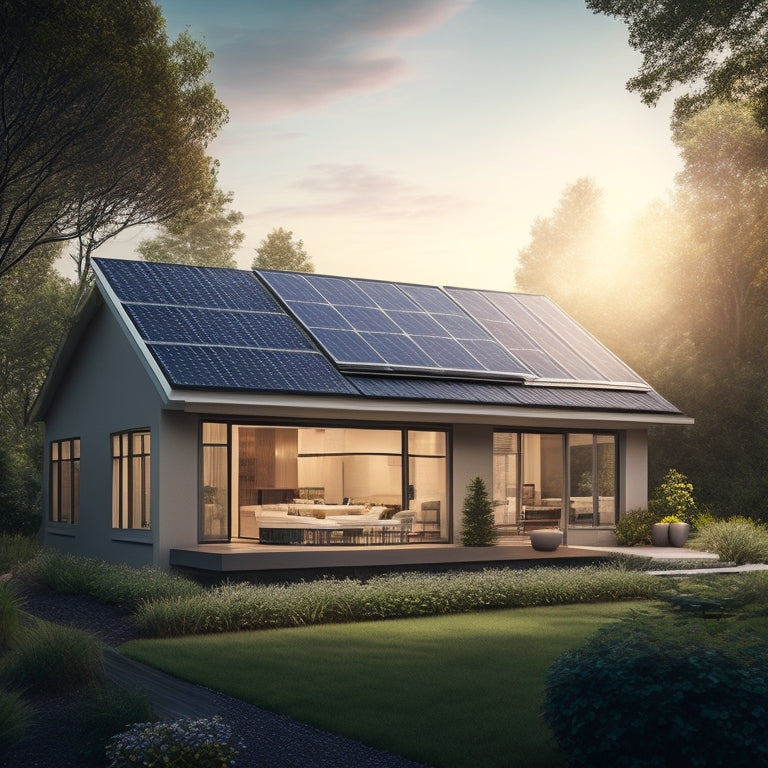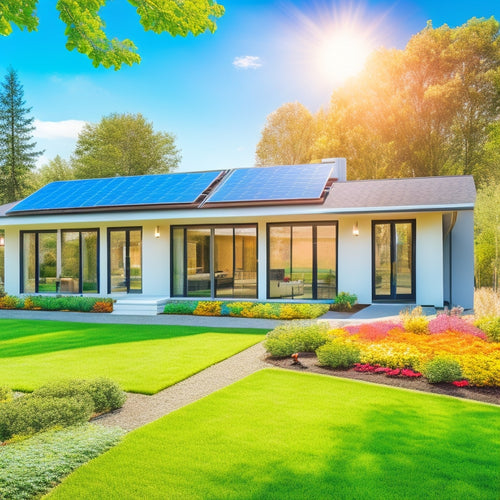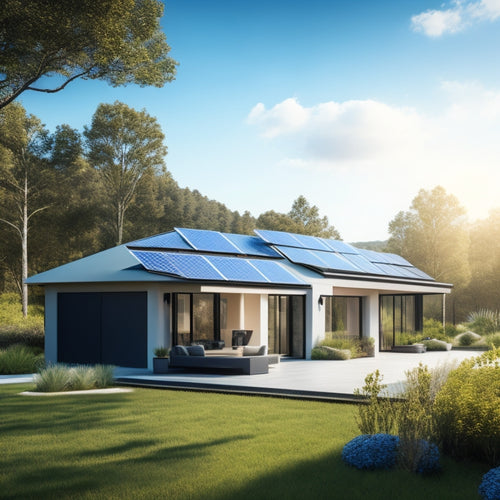
How to Power Your Home With Solar Energy in 7 Steps
Share
You'll power your home with solar energy in 7 steps. First, assess your energy needs by reviewing past utility bills and identifying high-energy appliances to reduce consumption. Next, choose the right system, considering grid-tied or off-grid options, and evaluate budget considerations. Inspect your roof's condition, confirming it can support solar panels, and select the right panel type based on energy needs and performance factors. Professional installation is essential, followed by system installation, connection to the grid, and finally, monitoring and maintaining performance. By following these steps, you'll be on your way to utilizing the sun's energy - and there's more to investigate to guarantee a seamless change.
Key Takeaways
- Assess your energy needs by reviewing past utility bills and identifying high-energy appliances to optimize your solar energy system.
- Choose the right solar panel type based on your energy needs, roof space, and budget, considering factors like efficiency and long-term savings.
- Ensure a professional installation that meets local building codes and regulations, with optimized panel placement for maximum energy output.
- Obtain necessary permits and connect your solar system to the grid, allowing you to sell excess energy back to the utility company.
- Regularly monitor and maintain your solar system's performance through inspections, software updates, and cleaning to ensure optimal energy production.
Assess Your Energy Needs
Efficiency begins with a thorough understanding of your energy requirements. You need to know how much power your home consumes to determine the size of the solar panel system you'll require. Start by reviewing your past utility bills to calculate your average daily energy consumption.
Identify the appliances and devices that use the most energy and consider ways to reduce their consumption.
Next, assess your energy usage patterns. Do you use more energy during the day or at night? Are there specific times of the year when your energy consumption spikes? This information will help you optimize your solar panel system's performance and maximize your solar savings.
You can also use online tools or consult with a solar expert to conduct a more detailed energy audit. They'll help you identify areas for improvement and provide personalized recommendations for reducing your energy consumption.
Choose the Right System
Typically, homeowners have two primary options for solar panel systems: grid-tied and off-grid systems.
Grid-tied systems are connected to the grid, allowing you to sell excess energy back to the utility company and offset your energy costs. Off-grid systems, on the other hand, are standalone and not connected to the grid, making them ideal for remote locations or areas with frequent power outages.
When choosing between these options, consider system compatibility with your existing electrical infrastructure. Verify the system you select is compatible with your home's electrical panel and wiring.
You'll also need to assess your budget considerations, as the cost of the system will vary depending on the type and size you require. A grid-tied system may be more cost-effective, while an off-grid system may require additional components, such as batteries, to store excess energy.
Ultimately, the right system for you'll depend on your energy needs, budget, and location.
Carefully evaluate your options to confirm you select a system that meets your energy goals and provides a strong return on investment.
Inspect Your Roof Condition
You'll want to assess your roof's age, as most solar panels are designed to last 25 years or more, and an older roof may need replacement before installation.
Additionally, you'll need to check the structural integrity of your roof to guarantee it can support the weight of the solar panels.
A thorough inspection will help determine if repairs or replacement are necessary before proceeding with solar panel installation.
Roof Age Matters
Since your solar panels will be mounted on your roof, its condition plays a significant role in determining the success of your solar energy system.
You'll want to verify your roof is in good shape to support the added weight of the panels and withstand various weather conditions.
If your roof is nearing the end of its lifespan, it's wise to contemplate a roof replacement before installing solar panels.
This is because you won't want to remove the panels to replace the roof later on, which can be costly. In fact, many solar incentives require your roof to be in good condition or recently replaced to qualify for the incentives.
Typically, a roof with 10-15 years of life left is regarded as suitable for solar panels.
If your roof is older, you may need to replace it before proceeding with the installation.
Consult with a professional to assess your roof's condition and provide guidance on the best course of action.
Structural Integrity Check
Inspect your roof's structural integrity by examining its underlying structure, as any weaknesses or damage can compromise the entire solar energy system.
You'll need to assess the foundation stability of your roof to guarantee it can support the added weight of solar panels. Perform a load analysis to determine if your roof can handle the increased weight, considering factors like snow loads, wind resistance, and seismic activity.
Check for signs of wear and tear, such as cracks, sagging, or unevenness. Verify that your roof's framing, sheathing, and underlayment are in good condition.
Look for any signs of water damage, rot, or pest infestation that could weaken the structure. Confirm that your roof's ventilation system is functioning properly to prevent moisture buildup.
It's vital to identify and address any structural issues before installing solar panels. A compromised roof structure can lead to safety hazards, reduced energy efficiency, and costly repairs down the line.
Select a Solar Panel Type
You'll need to choose a solar panel type that suits your energy needs, considering factors like panel efficiency rating, system size options, and energy output capacity.
This selection will greatly impact your system's overall performance and cost.
Panel Efficiency Rating
When selecting a solar panel type, a critical factor to take into account is the panel efficiency rating, which directly impacts the amount of energy your system can generate. This rating measures the energy conversion efficiency of your solar panel technology, which is the percentage of sunlight that's converted into usable electricity.
Here are four key aspects to ponder when evaluating panel efficiency ratings:
-
Higher is better: A higher efficiency rating means more energy is generated per unit area, making the most of your available roof space.
-
Efficiency ranges: Commercial solar panels typically have efficiencies between 15% and 22%, with high-efficiency panels usually costing more.
-
Balance with cost: While high-efficiency panels are desirable, they may not be the best value if you're on a budget. You'll need to balance efficiency with cost to get the most bang for your buck.
- Manufacturer claims: Be wary of exaggerated efficiency claims and look for third-party certifications, such as those from the International Electrotechnical Commission (IEC), to verify the ratings are accurate.
System Size Options
Most homes require a solar panel system between 3 and 10 kilowatts to meet their energy needs. When selecting a solar panel type, you'll need to take into account system size options that factor in your energy usage, roof size, and local building codes.
You'll want to determine the ideal solar array configuration for your home, which involves system capacity calculations. These calculations involve evaluating your energy usage patterns, including your peak sun hours, and determining the number of panels needed to meet your energy demands.
For instance, a 5-kilowatt system might require 15-20 panels, depending on their wattage and efficiency rating. You'll also need to take into account the physical space available on your roof, as well as any obstructions that might affect energy production.
Energy Output Capacity
Selecting the right solar panel type is essential for achieving ideal energy output capacity, as different types vary considerably in their performance and efficiency.
You'll want to choose a panel that suits your energy needs and budget.
When selecting a solar panel type, consider the following factors:
-
Efficiency rating: Higher efficiency ratings mean more power per hour of sunlight.
-
Durability: Look for panels with a long warranty (25 years or more) and proven track record.
-
Cost: Balance upfront cost with long-term energy savings and potential solar incentives.
- Compatibility: Verify the panel type is compatible with your energy storage system and inverter.
Install the Solar System
By this stage, you've carefully assessed your energy needs and chosen the right solar panel system for your home. Now it's time to install the solar system. This is a critical step that requires attention to detail and technical skill.
Seek professional installation to guarantee a safe and efficient setup. A qualified solar installer will assess your roof's condition, confirming it can support the solar panels' weight and withstand environmental factors. They'll also optimize panel placement to maximize energy output.
When it comes to solar installation tips, it's crucial to follow local building codes and regulations. Verify your installer is certified and has experience with similar projects. They should provide a detailed installation plan, including a timeline and warranty information.
During the installation process, your installer will connect the solar panels to an inverter, which converts DC power to AC power for your home.
They'll also install a monitoring system to track your energy production and identify potential issues. With a professional installation, you can rest easy knowing your solar system will operate efficiently and effectively, providing you with a reliable source of clean energy.
Connect to the Grid
Your solar panel system is now installed, and it's time to connect it to the grid. This step is essential in achieving energy independence and reducing your reliance on the utility company.
A grid connection allows you to sell any excess energy produced by your solar panels back to the grid and offset your energy consumption during periods of low sunlight.
To connect to the grid, follow these steps:
-
Obtain necessary permits: Verify you have all the necessary permits and approvals from your local government and utility company before proceeding with the grid connection.
-
Install a grid tie inverter: This device synchronizes your solar panel system's output with the grid's frequency and voltage, allowing you to feed excess energy back into the grid.
-
Connect to the grid: A licensed electrician will connect your solar panel system to the grid, typically through a net meter.
- Schedule a grid connection inspection: The utility company will inspect your grid connection to verify it meets their safety and technical requirements.
Once you've completed these steps, you'll be able to enjoy the benefits of solar energy and take a significant step towards energy independence.
Monitor and Maintain Performance
Now that you've successfully connected your solar panel system to the grid, it's time to shift your focus to guaranteeing it operates at peak performance.
Performance tracking is essential to identify any potential issues and enhance energy production. You'll need to monitor your system's energy output, reviewing data on a regular basis to detect any anomalies. Most modern solar panel systems come equipped with monitoring systems that provide real-time data on energy production, allowing you to track your system's performance remotely.
To maintain ideal performance, follow these maintenance tips: inspect your solar panels regularly to confirm they're free from debris and dirt; check your system's connections and wiring for signs of wear or damage; and schedule annual professional maintenance checks to identify and address any potential issues before they become major problems.
Additionally, keep your system's software and firmware up to date to guarantee you have access to the latest features and performance enhancements.
Frequently Asked Questions
Can I Install Solar Panels on a Rented Property?
You'll need to negotiate with your landlord to install solar panels on a rented property, understanding your renter rights and exploring solar panel options that work for both parties, like community solar programs or portable systems.
How Long Does It Take to Pay off Solar Panel Installation?
You'll typically see a solar payback period of 5-10 years, depending on your energy usage and local incentives. As a smart investment, solar panels provide attractive returns, saving you money on electricity bills while increasing your property's value.
Are There Any Federal Incentives for Solar Energy?
You're literally saving the planet, and Uncle Sam is rewarding you! You'll get a 30% federal tax credit on your solar panel installation, plus access to competitive solar energy grants, making your eco-friendly move a financially savvy one too!
Can I Use Solar Energy to Charge My Electric Vehicle?
You can utilize solar energy to charge your electric vehicle, enjoying EV benefits like reduced emissions and lower operating costs. With solar charging, you'll generate clean energy, offsetting your EV's power consumption and maximizing your eco-friendly investment.
Will Solar Panels Increase My Property Taxes?
You'll be glad to know that, in most states, you won't see a significant increase in property taxes due to solar panels, as the added value from the solar panel installation is often exempt from the property tax assessment.
Conclusion
You've made it this far, and now the countdown begins. Your solar-powered home is just a few connections away from utilizing the infinite energy of the sun. As you flip the switch, the anticipation builds. Will the lights turn on? Will the appliances hum to life? The answer lies in the efficiency of your system, and the payoff is a lifetime of clean, sustainable energy. The wait is almost over – get ready to bask in the glow of your new solar-powered home.
Related Posts
-

How Solar Panels Increase Property Value
Installing solar panels considerably increases your property value by improving energy efficiency and attracting eco-...
-

Integrating Smart Technology for Energy Savings
Integrating smart technology into your home is a transformative factor for energy savings. Smart thermostats give you...
-

Eco-Friendly Energy Storage Systems for Houses
Eco-friendly energy storage systems for your house let you capture and use renewable energy efficiently. You can choo...


